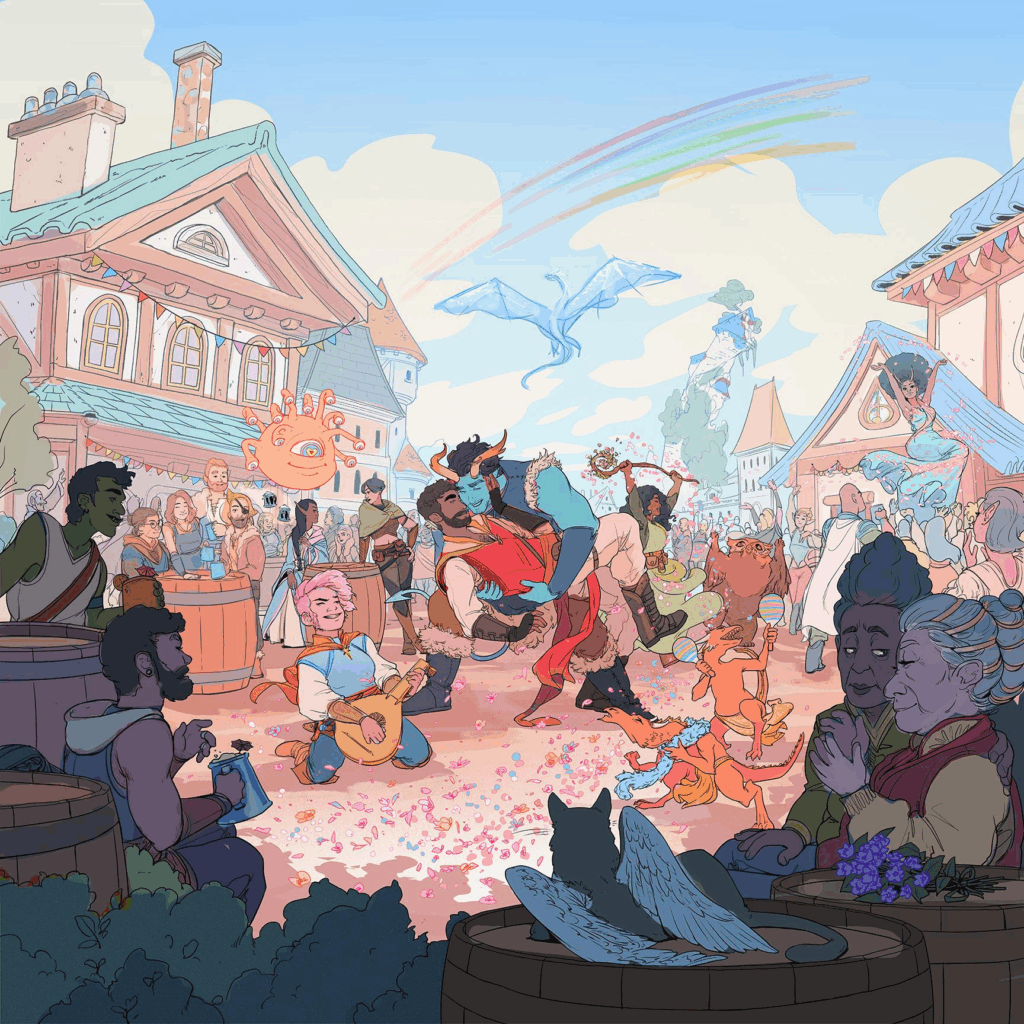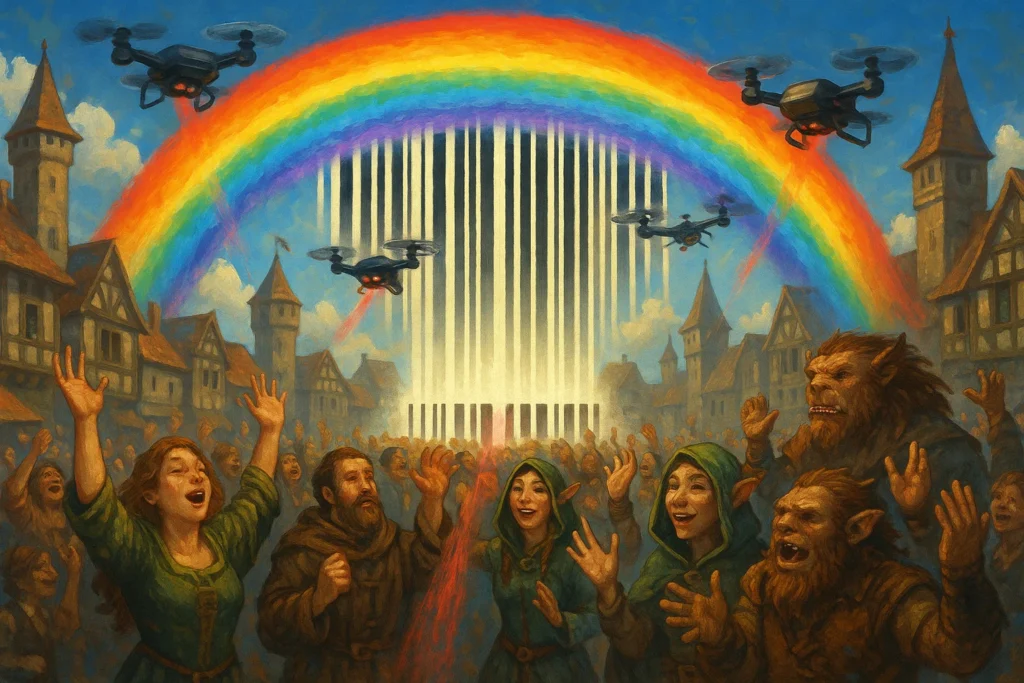On October 15, 2025, Wizards of the Coast unveiled a new piece of official Dungeons & Dragons artwork on X (formerly Twitter). It depicts a jubilant street festival in a medieval-style town—confetti drifting through the air, a rainbow arcing overhead, and smiling fantasy races dancing together in harmony. Even a Beholder, once a monster of terror and madness, floats playfully above the crowd. The post’s caption framed it as a celebration of community and belonging within the D&D universe.
Yet behind the brightness and cheer lies something deeper: a visual manifesto of the new order. What once depicted peril, mystery, and adventure now preaches harmony, identity, and inclusion. It isn’t fantasy anymore—it’s compliance.

This new Dungeons & Dragons artwork is not a celebration of adventure—it’s a celebration of ideology. It’s not depicting a living world of mystery, peril, and wonder; it’s a postcard from a managed utopia, a self-congratulatory tableau of moral messaging disguised as fantasy.
At first glance, the art is lively and charming. But linger, and the hollowness becomes clear. There are no heroes, no quests, no shadows. There is no danger, no unknown—the very essence of fantasy storytelling has been sterilized. The sword has been traded for the selfie.
The Utopia of the Unthreatened
In classical fantasy, towns like this were safe havens—temporary respites between journeys into the wild. Here, the town itself is the adventure, because there’s nothing beyond it. Every monster has been tamed, every boundary dissolved, every distinction flattened. The beholder, once an embodiment of paranoia and control, is now a party guest. Dragons play overhead like inflatable mascots. The moral inversion is total: the symbols of danger and evil are now benign, and the players are expected to applaud this as “progress.”
The rainbow arcing across the sky is not subtle—it’s the new heraldry of the brand. It signals the same thing it does in every corporate campaign: that identity has replaced imagination. The message isn’t “imagine worlds beyond your own,” but “this world, perfected, is all you need.”
The Death of Mythic Conflict
Fantasy used to thrive on moral polarity. Light versus darkness. Civilization versus chaos. Heroism demanded contrast—you became brave because there was something worth fearing. This artwork denies the existence of evil altogether. It’s a frictionless world, where everything has already been reconciled and no one ever needs to choose sides.

This is the fantasy of HR departments and social engineers: a world where no one offends, no one fights, and no one matters because nothing is at stake. The very act of struggle—the moral core of every D&D campaign—has been replaced by the illusion of harmony.
The Architecture of Erasure
The two English-style buildings aren’t nostalgic callbacks—they’re architectural ghosts. They stand as hollowed-out relics of the European medievalism D&D was built upon, now repurposed as stage props in a performance that denies their cultural context. This isn’t inclusion—it’s aesthetic colonization. The half-timbered structures now host a social experiment that would be foreign to the civilizations that produced such architecture, making them mere set pieces in someone else’s engineered harmony.
The Management of Myth
The tamed beholder and decorative dragon represent something far more sinister than creative liberty—they showcase the administrative impulse to control and sanitize all elements of danger, mystery, and moral complexity. These creatures aren’t just friendly; they’ve been assimilated into a bureaucratic order that despises uncertainty. This reflects the modern tendency to institutionalize everything wild, ancient, or potentially offensive until all edges are smoothed away into corporate-approved harmony.

The Hierarchy of Values
Note the deliberate visual hierarchy: the non-traditional central relationship is surrounded by approval and celebration, while traditional familial structures are either absent or marginalized. This isn’t accidental composition—it’s value signaling. The artwork teaches players what to celebrate and what to ignore through its visual language. The confetti, rainbows, and cheering crowds all direct attention toward the curated “virtuous” elements while implicitly dismissing unchampioned alternatives.
The Fantasy of Statism
This artwork depicts what happens when fantasy becomes state-managed: everyone is happy, everything is safe, and all dissent has been resolved through administrative means. The beholder isn’t just friendly—it’s been incorporated. The dragon isn’t just passing through—it’s been productized. This mirrors the modern bureaucratic ideal where all wildness is domesticated, all risk is mitigated, and everything exists to serve the collective under managerial oversight.
The Replacement of Sacred With Social
Traditional fantasy often featured churches, temples, and spiritual iconography—all absent here. The rainbow has replaced the cathedral spire as the dominant vertical element. Community celebration has replaced worship. Social validation has replaced spiritual seeking. This is the secularization of fantasy: the transcendental has been replaced with the social, the sacred with the approved.
The Architects of Alignment
This vision doesn’t spring from the void. It is handed down from a new class of corporate architect—managers whose expertise lies not in worldbuilding, but in compliance engineering.
Two executives now personify how corporate ideology seeps into creative worlds. John Hight, the former Blizzard veteran who now runs Wizards of the Coast, brings the Blizzard playbook of content management to Dungeons & Dragons: DEI conformity, risk mitigation, and aesthetic sterilization presented as “new storytelling opportunities.” Under his watch, D&D adopted the same reforms he once oversaw in World of Warcraft—gender-neutral character creation, shoehorned LGBTQ characters and stories, identity-centric lore updates, and a marketing tone that treats alignment not as moral choice but as corporate duty.

Beside him stands Holly Barbacovi, Hasbro’s Chief People Officer and a career HR strategist who has cycled through Microsoft, Amazon Games, Wizards, and Bungie. Her remit is culture and “people strategy,” meaning the company’s entire creative ecosystem—hiring, promotion, internal training, even narrative sensitivity—now flows through a global DE&I framework that doubles as ESG compliance. She represents the institutionalization of virtue itself: morality rendered as a measurable deliverable.
Together, Hight and Barbacovi embody the fusion of administration and morality that defines modern entertainment. One standardizes imagination from the production side; the other standardizes belief from the human side. Between them, the old creative frontier has been fully domesticated—fantasy reduced to an HR-approved sandbox patrolled by auditors of virtue.
The ESG Capture: Fantasy Audited
Behind the curated cheer of this artwork lies a truth more systemic than creative: it isn’t evolution—it’s compliance. The transformation of Dungeons & Dragons is not an artistic choice; it’s the visible enforcement arm of an invisible financial framework.
That framework is ESG—Environmental, Social, and Governance—a system of corporate scoring that now dictates the moral and aesthetic boundaries of our largest creative enterprises. For a publicly traded conglomerate like Hasbro, ESG is not a suggestion; it is a financial imperative.
Institutional investors such as BlackRock, Vanguard, and State Street—controlling trillions in capital—now allocate funds based on ESG scores. A high score unlocks favorable financing, lowers risk, and guarantees corporate stability. A low score can trigger capital flight, shareholder activism, and reputational damage. In this model, the “S” or Social pillar is the most corrosive to creative integrity because it measures adherence to progressive social engineering—diversity quotas, LGBTQ+ visibility, and the ideological tone of public communications.
The same funds have pressured companies across the entertainment sector—from Disney to Netflix to Hasbro—to produce quantifiable “representation metrics.” Storytelling itself has become a line item in ESG accounting.
This new Dungeons & Dragons artwork isn’t creative expression—it’s a visual ESG audit, a report card masquerading as a painting. Every element has been engineered to maximize that “Social” score:
- The rainbow arching across the sky isn’t a nod to in-world myth; it’s a corporate signal of alignment with approved social values—a box ticked for diversity metrics.
- The central, non-traditional relationship isn’t there for narrative depth; it’s a performative exhibit of inclusion designed to satisfy stakeholders who will never roll a D20.
- The removal of biological sex from character creation isn’t about freedom; it’s a preemptive strike against binary “exclusion” that might threaten ESG compliance.
- The taming of monsters and erasure of conflict isn’t storytelling innovation; it’s risk management, sanitizing content to eliminate anything that could offend the auditors.
This is the work of a new managerial class. Figures like John Hight and Holly Barbacovi personify this order—executives fluent in the language of ESG and DEI, hired not for passion but for compliance literacy. Their mandate isn’t to steward imagination; it’s to optimize brands for the algorithms of global capital. They are intermediaries between the creative past and the corporatized future. Their loyalty is to the scorecard, not the sword.

What we are witnessing, therefore, is not the natural death of a genre but a hostile takeover by financialized activism. The fantasy has not faded—it has been asset-stripped. The soul of Dungeons & Dragons is being liquidated to maintain a pristine ESG rating and the predictable flow of institutional investment.
The rainbow in the sky isn’t magic—it’s a barcode. Fantasy is been audited by external commissars.
Conclusion: The End of Adventure
Everything now fits together. The cheerful utopia of the artwork, the tamed monsters, the missing temples, the smiling crowd—it all serves one end: to prove compliance. Under the soft pastels lies a fully managed world, governed by the moral math of ESG and the managerial class that enforces it.
What began as a game of peril and imagination has been remade into a classroom of correct thought. The quest has been replaced by consensus. The hero’s journey has been replaced by the corporate seminar.
Yet there’s a strange poetic justice in this revelation. The very systems that promised safety and inclusion have finally revealed what they truly are: not creative forces but accounting systems for the soul. In chasing perfection, they have destroyed the only thing that made fantasy beautiful—its danger, its mystery, its refusal to be tamed.
In the end, the world of Dungeons & Dragons didn’t die—it was acquired, audited, and approved.
And that’s how adventure ends: not with a dragon’s roar, but with a compliance report.
—Wolfshead





Your point about the state reminded me of an article I read recently: https://www.compactmag.com/article/the-fall-of-the-alpha-male-state/
Read this too: https://www.compactmag.com/article/the-great-feminization/
This article really hit the head about our society and where it’s gone horribly wrong.
Wow! Thanks for this! I will read this for sure.
I was just about to do an article on The Great Feminization. I read it yesterday. It’s an outstanding expose on what has gone wrong with the West. You can see it in video games.
Thanks again!
I couldn’t believe it that something could even “surpass” the Jaguar ad campaign, but they beat it.
This is awful, D&D characters and monsters are staples of Western fantasy gaming. How they denounced Gygax himself, similar to the situation J.K. Rowling and Harry Potter franchise trying to get rid of its very creator. I am not a fan of Harry Potter, not my books/style of fantasy, but J.K. Rowling has my deepest respect for being a good and clear thinking person that is strong enough to withstand all the many and vile attacks.
Also thanks for the photo of the two Execs behind this. A fine corporate culture example of “I really cannot smile even if I try hard, but see this uncanny fake smile”.